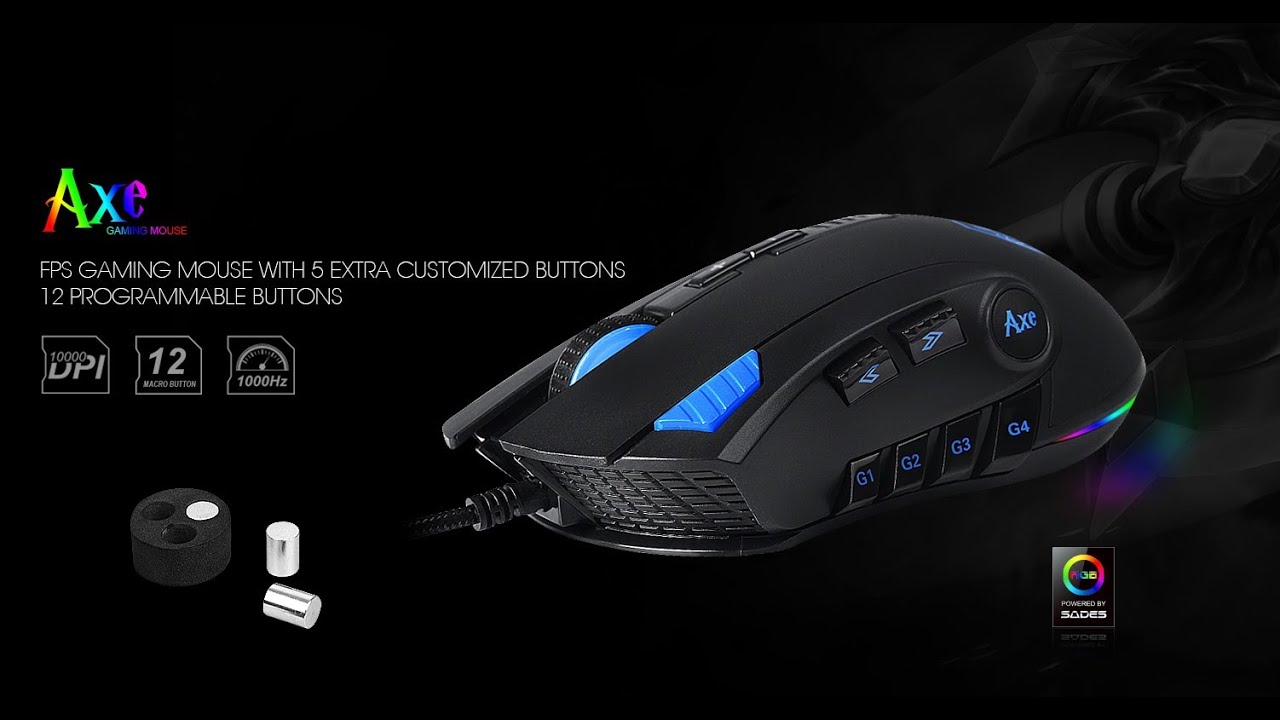The Sades Axe is a fully-featured mouse that performs way better than its budget price would suggest.
- Manufacturer: Sades
- Model: Axe
- Type: Wired Gaming Mouse (Right-handed/Ergonomic/RGB)
- Supported platforms: Windows 7/8/10
- Price when reviewed: £
- Supplied by: Manufacturer
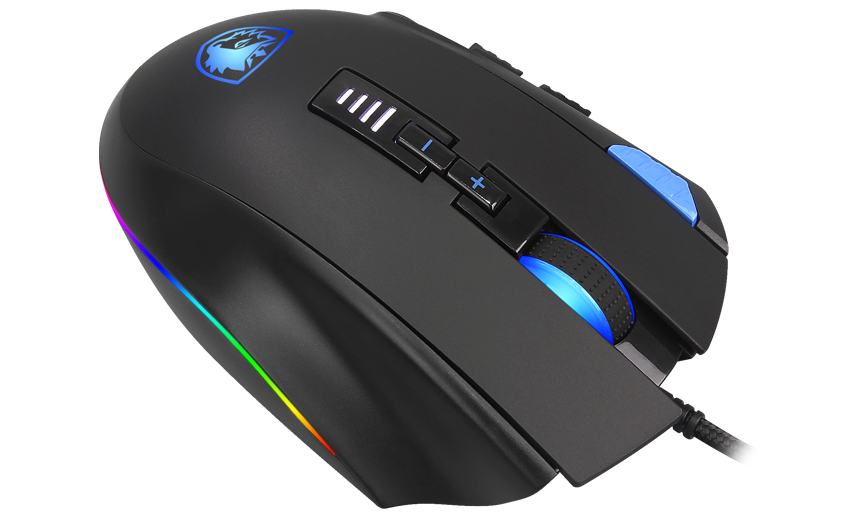
Sades hasn’t been around all that long, but they’ve been making a name for themselves with their very competitively priced gaming peripherals, including headsets, keyboards, mice, even gaming furniture. We reviewed the Sades Mpower gaming headset recently, praising its excellent sound quality and affordability, but were underwhelmed by some of the design choices. Overall, though, the Sades headset was great considering the price, and we’ve been keen to try out more of their products.
We were given the opportunity to take a look at the Sades Axe gaming mouse, and we’ve been pleasantly surprised. On paper, it has a very impressive spec sheet, but how would it perform under rigorous testing?
Design and build
Sades has done a great job with the presentation of the Axe. Packaged in a stylish box with a magnetic closure, it’s reminiscent of products from even the most high-end manufacturers. Inside the box, you will find your Axe mouse with integrated cable, a guarantee card, user manual, replacement footpads, the additional weights and some Sades stickers.


When I first held the Axe in my hand, I was caught off guard by the size. Across the right side of the mouse is an extended finger rest, and it needs quite a wide hand-span the way I hold a mouse. I wasn’t sure about it at first, but after I’d become familiar with the feel and adapted my grip, it was surprisingly comfortable.
The mouse is made from a relatively cheap-looking plastic, but for the price, I’d always prefer they spend more on the sensor and switches than on the chassis. Most of the mouse is covered in a finely textured matte black finish, with a thin translucent strip around the base for the RGB, a light-up Sades logo and a light blue fire button mounted just beside the left mouse button adding a touch of colour. When the RGB is fired up and casting a subtle glow onto the desk it’s a very nice looking mouse.
It’s quite a lightweight mouse, but there are additional 10.5g weights that can be inserted into the base, similar to the method utilised by Logitech and others. It helps bring the mouse weight more in line with other competitive mice and it has a good feel in the hand.
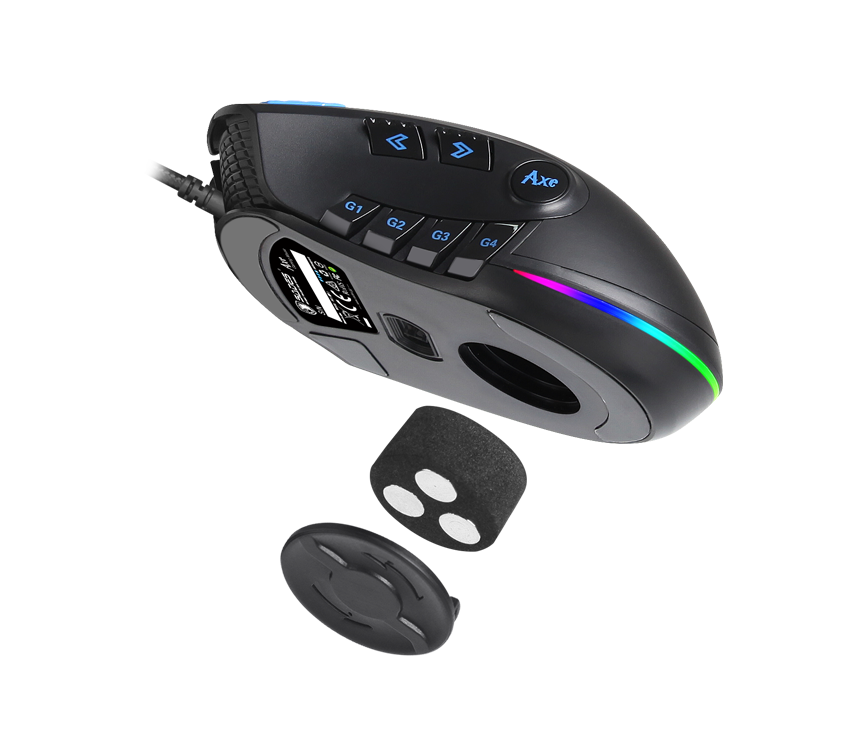
You’d better RGBelieve it!
Sades’ Axe features extensive RGB lighting that has been very well implemented. Twelve pre-programmed routines can be selected by pressing the forward and centre mouse button together. It doesn’t have a sync feature, but by downloading the control software you have excellent levels of control over the light intensity, dynamic lighting patterns, and even individually addressable RGB for each of the 8 LED zones (circumnavigating the base and under the scroll wheel.)
Push the button(s)
In addition to the standard configuration of left and right mouse buttons, scroll wheel and centre button, there are several additional programmable buttons. You get; left and right scroll, a pair of switches beneath the scroll wheel to select from six customisable DPI presets, a forward and back button towards the top of the thumb grip, a fire button beside the LMB, and perhaps the most unique feature, a set of four additional buttons in the centre of the thumb grip.
Through the Sades control software, you can assign various functions and macros to each of the twelve programmable buttons. The fire button, in addition to the usual options, also has an autofire function, which is something I haven’t come across in years. It can be configured to activate any keypress, and can be set to single, double or triple-click, or utilise customisable variable-rate rapid-fire functionality. If you play any games that require you to rapidly press any key or button, simply assign it to the fire button and let the Axe do the hard work for you.
The additional buttons along the thumb grip are extremely useful, but I did find that the curve of the mouse body made them slightly awkward to hit consistently. As with any controller, though, the more I used them the more consistent I became. Having these four extra inputs within easy reach is a huge advantage while gaming, especially with the option to assign macros to them too.


Performance
The lift-off height is quite high on the Axe, but not so much to be problematic, it just takes a little adjustment if you are used to only minimal amounts of lift-off. Moving the mouse around the desk is also smooth and well-balanced, but my initial reaction wasn’t so good: When I first tried the Axe, sliding it around my desk was a jerky affair, and I felt the mouse sticking. I tried cleaning the desk, then tried it on a different mouse mat, but I kept having issues moving it consistently at low speeds.
After a more careful examination, I found the footpads had peel-off plastic coverings on them. Once I removed these, it made a big difference but it was still catching on something. This time, the culprit was a QC pass sticker! After removing all of the offending items, it felt like a new mouse.
Sades has fitted the Axe with a PMW3325 sensor, rated for 20G acceleration. I’ve seen reports that this sensor has issues with spin-out at high speeds, but I never experienced it in normal use. After reading the reports, I went out of my way to try to get the sensor to fail, but it kept up no matter how fast I whipped the mouse from side to side, maintaining a consistent horizontal axis.
The polling rate defaults at 500Hz, but can be increased to 1000Hz (1 millisecond) putting it on par with even the most expensive mice on the market.
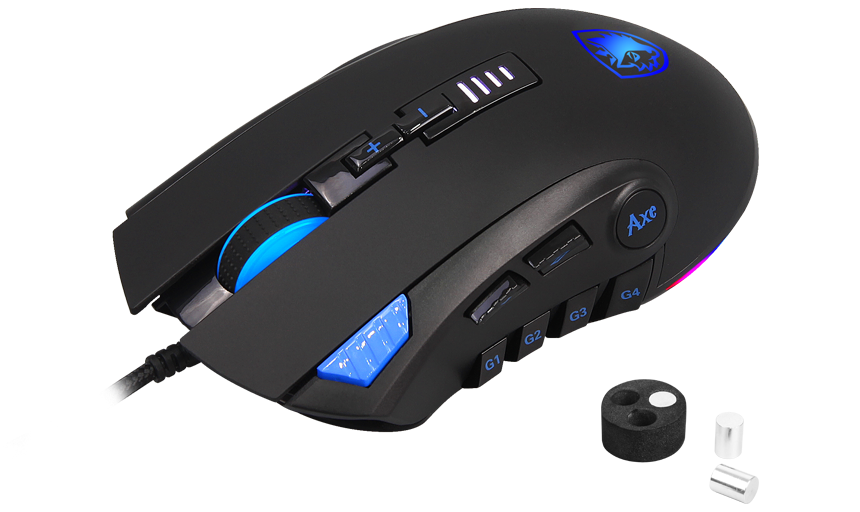
Good, but not perfect
It responded well at most speeds, but there was a very small amount of jitter when making minute adjustments. It’s not quite as good as the best sensors on the market, but for a cheap sensor, it puts in a very respectable performance. Unless you are a serious competitive gamer or active professional, it’s unlikely to have a major impact on your gameplay.
Most of the switches on the Sades Axe work well, with the commonly used Omron switches providing a satisfying click, and the scroll wheel has a solid notch action without being too stiff. The left and right scroll buttons, however, don’t feel as responsive, with the left scroll button, in particular, lacking any definitive click and feeling restricted in its movement. This could just be a one-off manufacturing defect, but it does raise questions about the build quality. Thankfully, the customer service with Sades is very good, so if you do buy this mouse, check the buttons thoroughly and if there are any issues, they will swiftly exchange it for another unit.
Connection to your PC comes by way of a 1.8m braided nylon cable, terminating in a sturdy gold-plated USB connector. The cable is very good quality compared to some of the flimsy offerings used on other entry-level devices.
The Sades Axe is available for the very reasonable price of just £26.99 (Amazon). For this price, it’s an absolute steal. If you’re on a budget and need a good-looking mouse with better-than-average performance, you can’t go wrong with the Axe.
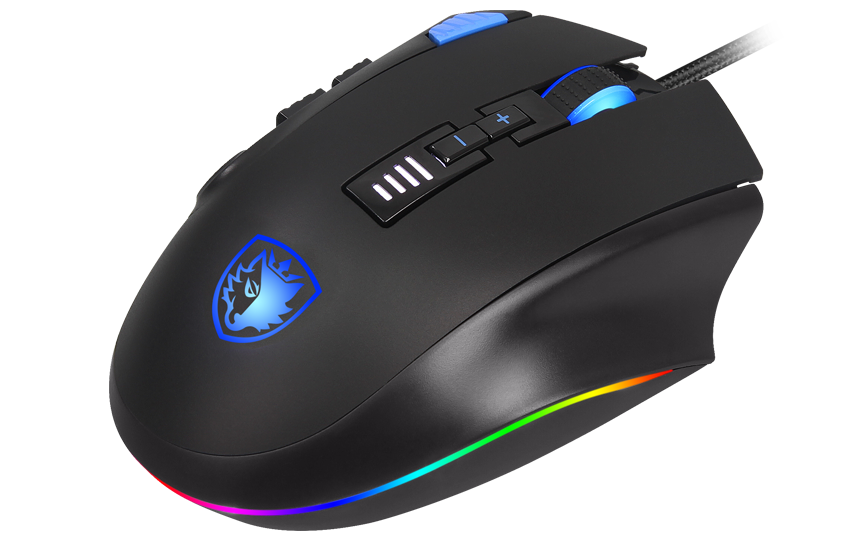
Summary
If you are on the hunt for a fully-featured gaming mouse that won’t break the bank, look no further. The Sades Axe ticks all the right boxes and even has a few nice added features that elevate it way above what you would expect for the asking price. A decent sensor, eye-catching addressable RGB and twelve customisable buttons make the Axe a very respectable offering, and surely one of the best budget mice on the market.
